2017 Peugeot 3008 Hybrid 4 fold seats
[x] Cancel search: fold seatsPage 83 of 578
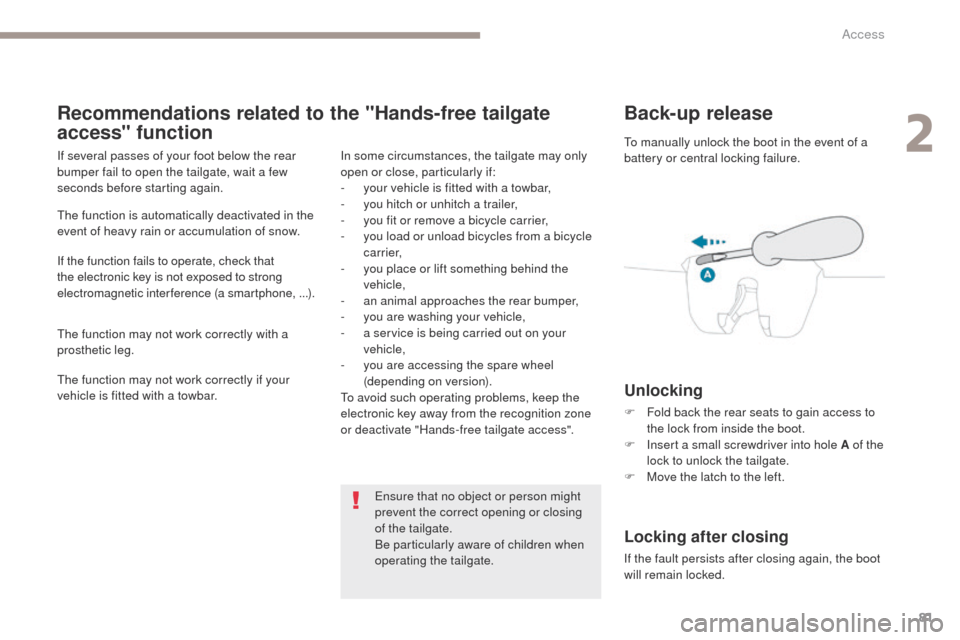
81
3008-2_en_Chap02_ouvertures_ed01-2016
Back-up release
Unlocking
F Fold back the rear seats to gain access to the lock from inside the boot.
F
I
nsert a small screwdriver into hole A of the
lock to unlock the tailgate.
F
M
ove the latch to the left.
Locking after closing
If the fault persists after closing again, the boot
will remain locked. To manually unlock the boot in the event of a
battery or central locking failure.
Recommendations related to the "Hands-free tailgate
access" function
If several passes of your foot below the rear
bumper fail to open the tailgate, wait a few
seconds before starting again.
The function is automatically deactivated in the
event of heavy rain or accumulation of snow.
If the function fails to operate, check that
the electronic key is not exposed to strong
electromagnetic interference (a smartphone, ...).
The function may not work correctly with a
prosthetic leg.
The function may not work correctly if your
vehicle is fitted with a towbar. In some circumstances, the tailgate may only
open or close, particularly if:
-
y
our vehicle is fitted with a towbar,
-
y
ou hitch or unhitch a trailer,
-
y
ou fit or remove a bicycle carrier,
-
y
ou load or unload bicycles from a bicycle
c a r r i e r,
-
y
ou place or lift something behind the
vehicle,
-
an
animal approaches the rear bumper,
-
y
ou are washing your vehicle,
-
a s
ervice is being carried out on your
vehicle,
-
y
ou are accessing the spare wheel
(depending on version).
To avoid such operating problems, keep the
electronic key away from the recognition zone
or deactivate "Hands-free tailgate access".
Ensure that no object or person might
prevent the correct opening or closing
of the tailgate.
Be particularly aware of children when
operating the tailgate.
2
Access
Page 94 of 578
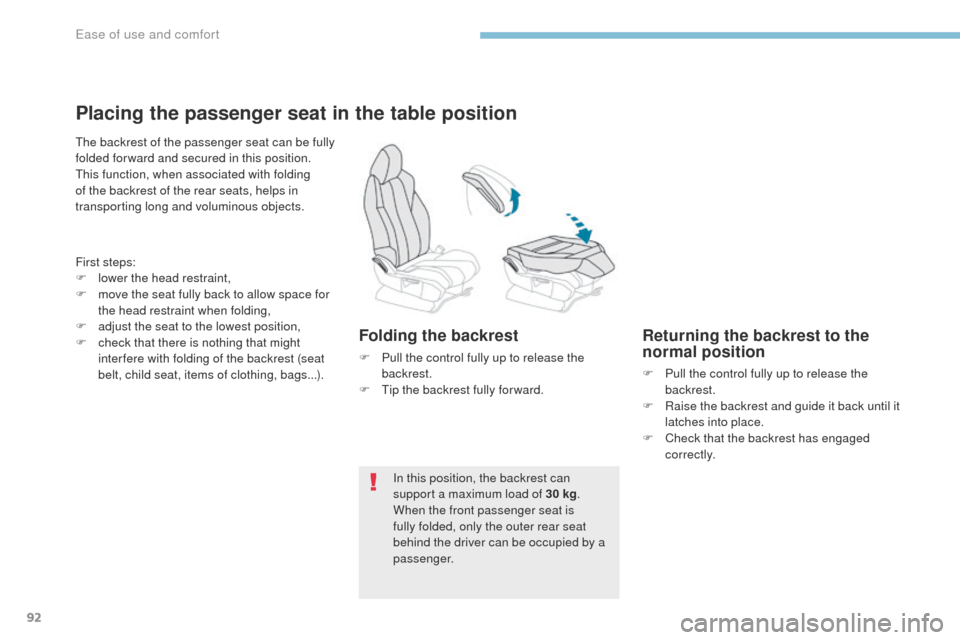
92
3008-2_en_Chap03_ergonomie-et-confort_ed01-2016
Placing the passenger seat in the table position
The backrest of the passenger seat can be fully
folded for ward and secured in this position.
This function, when associated with folding
of the backrest of the rear seats, helps in
transporting long and voluminous objects.
First steps:
F
l
ower the head restraint,
F
m
ove the seat fully back to allow space for
the head restraint when folding,
F
a
djust the seat to the lowest position,
F
c
heck that there is nothing that might
inter fere with folding of the backrest (seat
belt, child seat, items of clothing, bags...).
Folding the backrest
F Pull the control fully up to release the backrest.
F
T
ip the backrest fully for ward.
In this position, the backrest can
support a maximum load of 30 kg .
When the front passenger seat is
fully folded, only the outer rear seat
behind the driver can be occupied by a
passenger.
Returning the backrest to the
normal position
F Pull the control fully up to release the backrest.
F
R
aise the backrest and guide it back until it
latches into place.
F
C
heck that the backrest has engaged
c o r r e c t l y.
Ease of use and comfort
Page 132 of 578
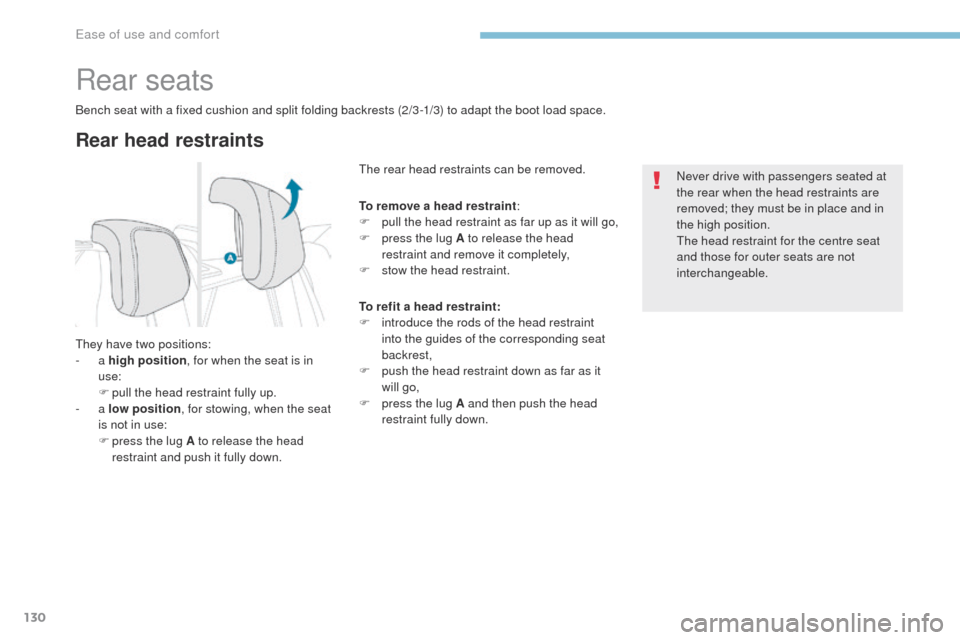
130
3008-2_en_Chap03_ergonomie-et-confort_ed01-2016
Rear seats
Rear head restraints
Bench seat with a fixed cushion and split folding backrests (2/3 -1/3) to adapt the boot load space.
They have two positions:
- a high position , for when the seat is in
use:
F
p
ull the head restraint fully up.
-
a low position , for stowing, when the seat
is not in use:
F
p
ress the lug A to release the head
restraint and push it fully down. The rear head restraints can be removed.
Never drive with passengers seated at
the rear when the head restraints are
removed; they must be in place and in
the high position.
The head restraint for the centre seat
and those for outer seats are not
interchangeable.
To remove a head restraint
:
F
p
ull the head restraint as far up as it will go,
F
p
ress the lug A to release the head
restraint and remove it completely,
F
s
tow the head restraint.
To refit a head restraint:
F
i
ntroduce the rods of the head restraint
into the guides of the corresponding seat
backrest,
F
p
ush the head restraint down as far as it
will go,
F
p
ress the lug A and then push the head
restraint fully down.
Ease of use and comfort
Page 133 of 578
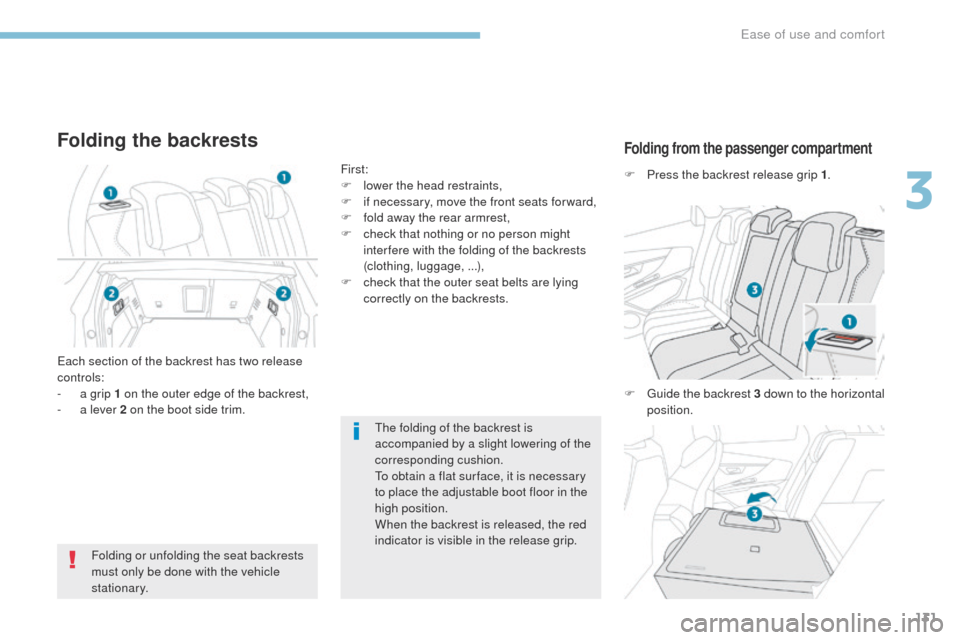
131
3008-2_en_Chap03_ergonomie-et-confort_ed01-2016
The folding of the backrest is
accompanied by a slight lowering of the
corresponding cushion.
To obtain a flat sur face, it is necessary
to place the adjustable boot floor in the
high position.
When the backrest is released, the red
indicator is visible in the release grip.
Folding from the passenger compartment
F Press the backrest release grip 1.
F
G
uide the backrest 3 down to the horizontal
position.
Folding the backrests
Each section of the backrest has two release
controls:
-
a g
rip 1 on the outer edge of the backrest,
-
a l
ever 2 on the boot side trim. First:
F
l
ower the head restraints,
F
i
f necessary, move the front seats for ward,
F
f
old away the rear armrest,
F
c
heck that nothing or no person might
inter fere with the folding of the backrests
(clothing, luggage, ...),
F
c
heck that the outer seat belts are lying
correctly on the backrests.
Folding or unfolding the seat backrests
must only be done with the vehicle
stationary.
3
Ease of use and comfort
Page 139 of 578
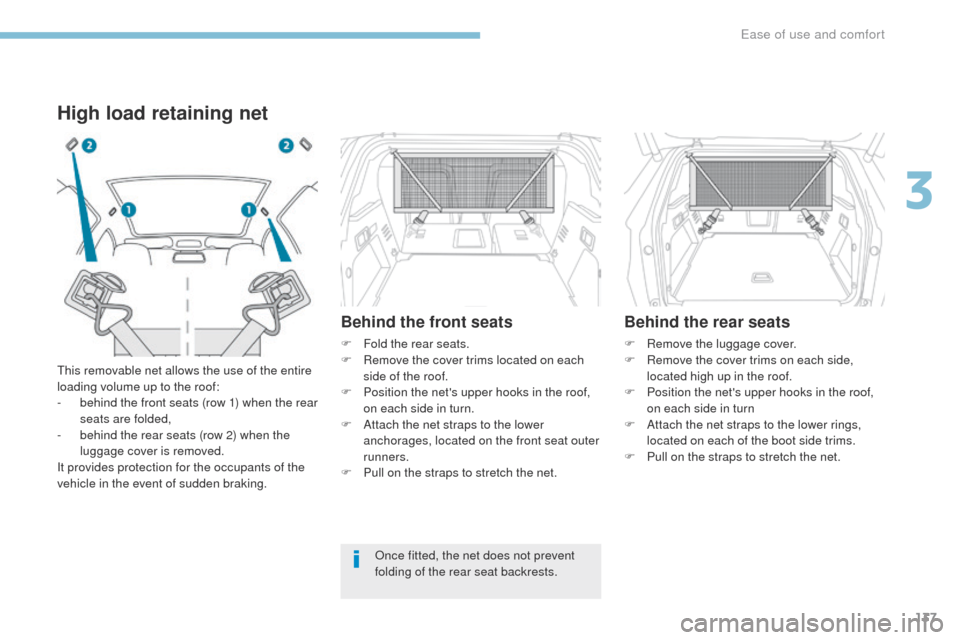
137
3008-2_en_Chap03_ergonomie-et-confort_ed01-2016
High load retaining net
This removable net allows the use of the entire
loading volume up to the roof:
-
b
ehind the front seats (row 1) when the rear
seats are folded,
-
b
ehind the rear seats (row 2) when the
luggage cover is removed.
It provides protection for the occupants of the
vehicle in the event of sudden braking.
Behind the front seats
F Fold the rear seats.
F R emove the cover trims located on each
side of the roof.
F
P
osition the net's upper hooks in the roof,
on each side in turn.
F
A
ttach the net straps to the lower
anchorages, located on the front seat outer
runners.
F
P
ull on the straps to stretch the net.
Behind the rear seats
F Remove the luggage cover.
F R emove the cover trims on each side,
located high up in the roof.
F
P
osition the net's upper hooks in the roof,
on each side in turn
F
A
ttach the net straps to the lower rings,
located on each of the boot side trims.
F
P
ull on the straps to stretch the net.
Once fitted, the net does not prevent
folding of the rear seat backrests.
3
Ease of use and comfort
Page 140 of 578
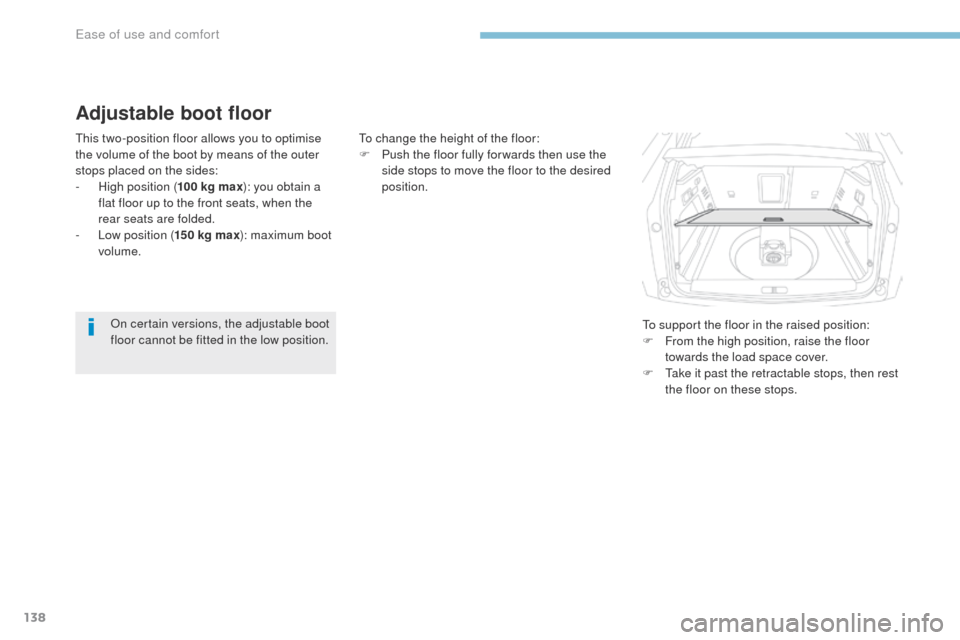
138
3008-2_en_Chap03_ergonomie-et-confort_ed01-2016
Adjustable boot floor
This two-position floor allows you to optimise
the volume of the boot by means of the outer
stops placed on the sides:
-
Hig
h position ( 100 kg max ): you obtain a
flat floor up to the front seats, when the
rear seats are folded.
-
L
ow position ( 150 kg max): maximum boot
volume. To change the height of the floor:
F
P ush the floor fully for wards then use the
side stops to move the floor to the desired
position.
To support the floor in the raised position:
F
F
rom the high position, raise the floor
towards the load space cover.
F
T
ake it past the retractable stops, then rest
the floor on these stops.
On certain versions, the adjustable boot
floor cannot be fitted in the low position.
Ease of use and comfort
Page 173 of 578
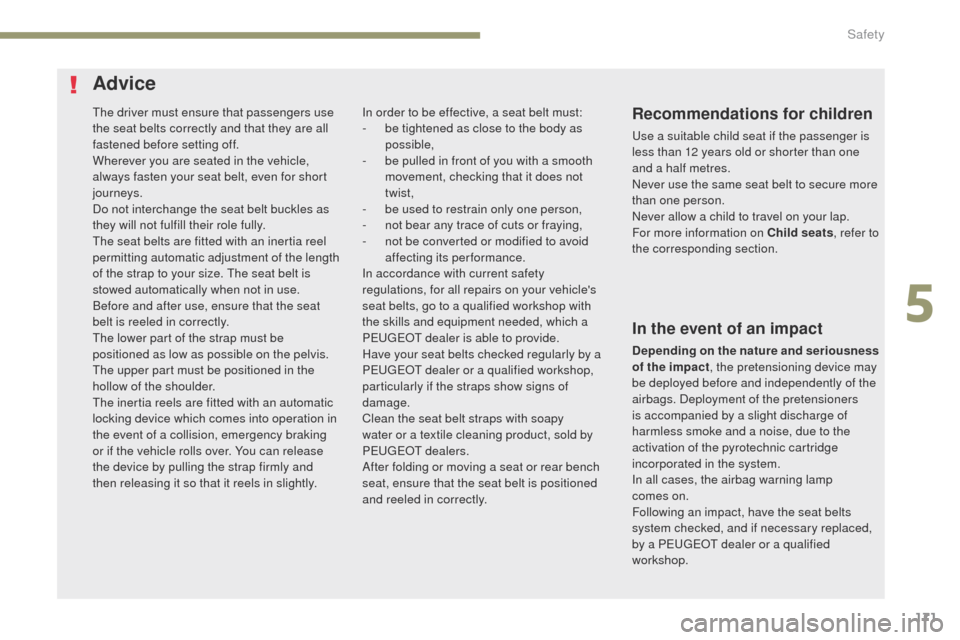
171
3008-2_en_Chap05_securite_ed01-2016
The driver must ensure that passengers use
the seat belts correctly and that they are all
fastened before setting off.
Wherever you are seated in the vehicle,
always fasten your seat belt, even for short
journeys.
Do not interchange the seat belt buckles as
they will not fulfill their role fully.
The seat belts are fitted with an inertia reel
permitting automatic adjustment of the length
of the strap to your size. The seat belt is
stowed automatically when not in use.
Before and after use, ensure that the seat
belt is reeled in correctly.
The lower part of the strap must be
positioned as low as possible on the pelvis.
The upper part must be positioned in the
hollow of the shoulder.
The inertia reels are fitted with an automatic
locking device which comes into operation in
the event of a collision, emergency braking
or if the vehicle rolls over. You can release
the device by pulling the strap firmly and
then releasing it so that it reels in slightly.Recommendations for children
Use a suitable child seat if the passenger is
less than 12 years old or shorter than one
and a half metres.
Never use the same seat belt to secure more
than one person.
Never allow a child to travel on your lap.
For more information on Child seats, refer to
the corresponding section.
In the event of an impact
Depending on the nature and seriousness
of the impact , the pretensioning device may
be deployed before and independently of the
airbags. Deployment of the pretensioners
is accompanied by a slight discharge of
harmless smoke and a noise, due to the
activation of the pyrotechnic cartridge
incorporated in the system.
In all cases, the airbag warning lamp
comes
on.
Following an impact, have the seat belts
system checked, and if necessary replaced,
by a PEUGEOT dealer or a qualified
workshop.
Advice
In order to be effective, a seat belt must:
- b e tightened as close to the body as
possible,
-
b
e pulled in front of you with a smooth
movement, checking that it does not
twist,
-
b
e used to restrain only one person,
-
n
ot bear any trace of cuts or fraying,
-
n
ot be converted or modified to avoid
affecting its performance.
In accordance with current safety
regulations, for all repairs on your vehicle's
seat belts, go to a qualified workshop with
the skills and equipment needed, which a
PEUGEOT dealer is able to provide.
Have your seat belts checked regularly by a
PEUGEOT dealer or a qualified workshop,
particularly if the straps show signs of
damage.
Clean the seat belt straps with soapy
water or a textile cleaning product, sold by
PEUGEOT dealers.
After folding or moving a seat or rear bench
seat, ensure that the seat belt is positioned
and reeled in correctly.
5
Safety
Page 349 of 578
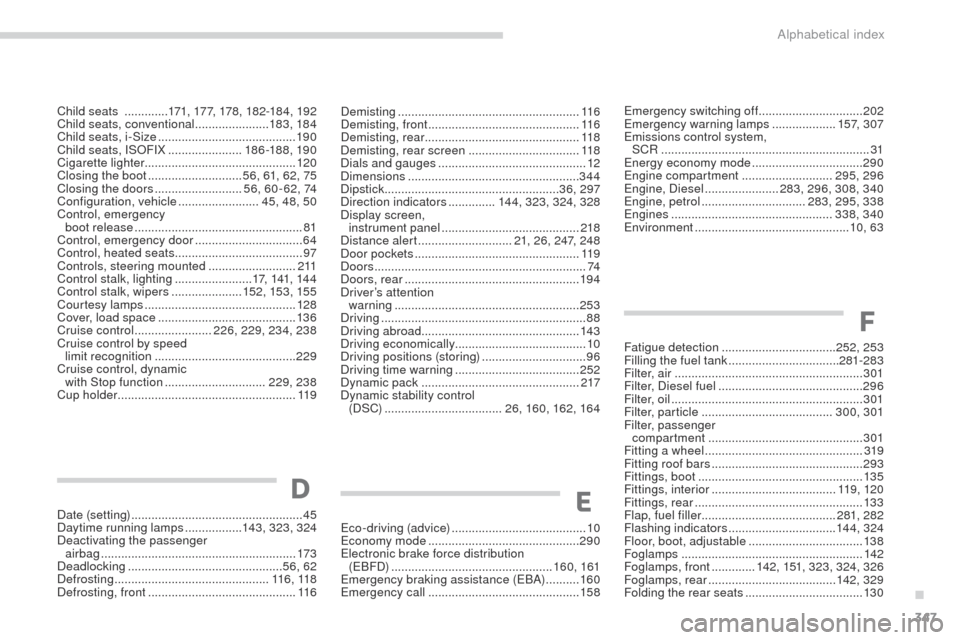
347
3008-2_en_Chap11_index-alpha_ed01-2016
Demisting ......................................................11 6
Demisting, front ............................................. 11 6
Demisting, rear
.............................................. 11
8
Demisting, rear screen
.................................118
Dials and gauges
............................................ 12
Dimensions
................................................... 344
Dipstick
................
.................................... 36, 297
Direction indicators
..............14 4, 323 , 324, 328
Display screen, instrument panel
...............................
..........218
Distance alert
............................ 21, 26 , 247 , 248
Door pockets
................................................. 11
9
Doors
............................................................... 74
Doors, rear
.................................................... 19 4
Driver’s attention warning
...............................
........................253
Driving
............................................................. 88
Driving abroad ............................................... 143
Driving economically ....................................... 10
Driving positions (storing)
...............................96
Driving time warning
..................................... 252
Dynamic pack
..............................
.................217
Dynamic stability control (DSC)
................................... 26, 160 , 162, 16 4 Emergency switching off ...............................
2 02
Emergency warning lamps ................... 15
7, 307
Emissions control system, SCR
..............................................................31
Energy economy mode
.................................290
Engine compartment
...........................295, 296
Engine, Diesel
...................... 28
3, 296 , 308 , 340
Engine, petrol
...............................283, 295 , 338
Engines
................................................338, 340
Environment
...............................
...............10, 63
Child seats
.............
17
1
, 17 7 , 178 , 182-18 4 , 192
Child seats, conventional
...................... 183, 18 4
Child seats, i-Size
...............................
.......... 19 0
Child seats, ISOFIX
...................... 18
6 -188 , 19 0
Cigarette lighter ............................................. 120
Closing the boot
............................ 56, 61 , 62 , 75
Closing the doors
.......................... 56, 60-62 , 74
Configuration, vehicle
........................ 45, 48 , 50
Control, emergency boot release
.................................................. 81
Control, emergency door
................................ 64
Control, heated seats
...................................... 97
Controls, steering mounted
.......................... 2 11
Control stalk, lighting
....................... 17,
141 , 14 4
Control stalk, wipers
..................... 152, 153 , 155
Courtesy lamps
............................................. 128
Cover, load space
......................................... 13
6
Cruise control
....................... 2
26 , 229 , 234 , 238
Cruise control by speed limit recognition
.......................................... 229
Cruise control, dynamic with Stop function
.............................. 229, 238
Cup holder
...............................
...................... 11 9
F
Fatigue detection .................................. 252, 253
Filling the fuel tank ................................. 28
1-283
Filter, air
...............
......................................... 301
Filter, Diesel fuel
........................................... 296
Filter, oil
......................................................... 301
Filter, particle
....................................... 300, 301
Filter, passenger compartment
.............................................. 3
01
Fitting a wheel
...............................
................319
Fitting roof bars
............................................. 293
Fittings, boot
................................................. 13
5
Fittings, interior
..................................... 11 9, 120
Fittings, rear
...............................
...................13 3
Flap, fuel filler
...............................
.........281, 282
Flashing indicators
................................ 14 4, 324
Floor, boot, adjustable
..................................13 8
Foglamps
...................................................... 142
Foglamps, front
.............142, 151 , 323 , 324, 326
Foglamps, rear
...................................... 142, 329
Folding the rear seats
...................................13 0
D
Date (setting) ............................... ....................45
Daytime running lamps .................143, 323 , 324
Deactivating the passenger airbag
.......................................................... 17
3
Deadlocking
.............................................. 56, 62
Defrosting
.............................................. 11 6, 118
Defrosting, front
............................................ 11
6E
Eco-driving (advice) ........................................ 10
Economy mode ............................................. 290
Electronic brake force distribution (EBFD)
................................................ 160, 161
Emergency braking assistance (EBA)
.......... 16
0
Emergency call
............................................. 15
8
.
Alphabetical index